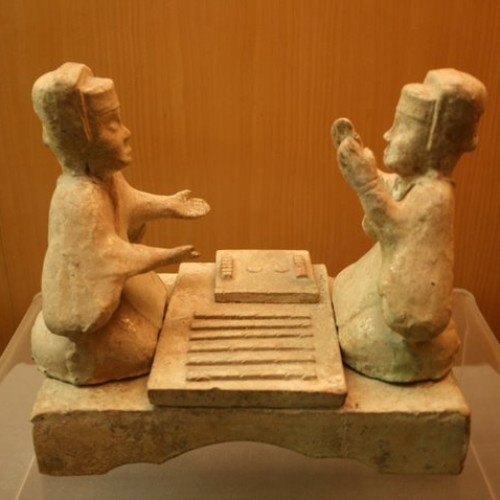HOUNDS AND JACKALS VS LIUBO

HOUNDS AND JACKALS
Hounds and jackals is the modern name given to an ancient Egyptian game that is known from several examples of gaming boards and gaming pieces found in excavations. The modern name was invented by Howard Carter, who found one complete gaming set in a Theban tomb of ancient Egyptian pharaoh Amenemhat IV that dates to the 12th Dynasty. The latter game set is one of the best preserved examples and is today in the Metropolitan Museum of Art in New York. He called it Hounds contra Jackals. Another, less often used modern name is fifty-eight holes. The gaming board has two sets of 29 holes. Gaming pieces are ten small sticks with either jackal or dog heads. The game appeared in Egypt, around 2000 BC and was mainly popular in the Middle Kingdom. In the 1956 movie The Ten Commandments, Pharaoh Seti (Cedric Hardwicke) and Nefretiri (Anne Baxter) are shown playing the game. Hounds and Jackals, also known as 58 Holes, is a well-known Bronze Age board game which was invented in Ancient Egypt 4,000 years ago. Hounds and Jackals appeared in Egypt, around 2000 BC and was mainly popular in the Middle Kingdom. William Mathew Flinders Petrie initially discovered the game and published about it in 1890. More than 40 examples of the game have been revealed in Egypt, Mesopotamia, Israel, Syria, Iran, Azerbaijan, around the Levant and Mediterranean since that time. Sticks were made of expensive materials such as ivory, silver and gold based on the findings at some of the archaeological sites. Wood was also used in the preparation of ordinary pegs, but such examples would not have survived. The complete set of this Egyptian game discovered in 1910 by the British archaeologist Howard Carter is now displayed in the Metropolitan Museum of Art in New York.
Statistics for this Xoptio

LIUBO
Liubo (Chinese: 六博 or 陸博; pinyin: liù bó; Wade–Giles: liu po; lit. 'six sticks') is an ancient Chinese board game played by two players. For the rules, it is believed that each player had six game pieces that were moved around the points of a square game board that had a distinctive, symmetrical pattern. Moves were determined by the throw of six sticks, which performed the same function as dice in other race games. The game was invented no later than the middle of the 1st millennium BCE, and was popular during the Han dynasty (202 BCE – 220 CE). However, after the Han Dynasty it rapidly declined in popularity, possibly due to the rise in popularity of the game of Go, and it became totally forgotten. Knowledge of the game has increased in recent years with archeological discoveries of Liubo game boards and game equipment in ancient tombs, as well as discoveries of Han dynasty picture stones and picture bricks depicting Liubo players. It is not known when the game of Liubo originated, although according to legend it was invented by Wu Cao (烏曹, called Wu Zhou 烏胄 in the early 2nd century CE Shuowen Jiezi dictionary), a minister to King Jie, the last king of the Xia dynasty, who according to traditional chronology reigned 1728–1675 BCE. While there is no archeological or reliable documentary evidence to support the view that Liubo dates back to the Shang dynasty (1600–1046 BCE), early Chinese records do indicate that Liubo was already a popular game by the Warring States period (476–221 BCE). For example, the Records of the Grand Historian records a speech made during the reign of King Xuan of Qi (reigned 319–301 BCE) that claims that the capital city of Linzi was so wealthy that its citizens were all able to indulge in activities such as playing musical instruments, cockfighting, dog racing, playing Liubo and playing kick ball.